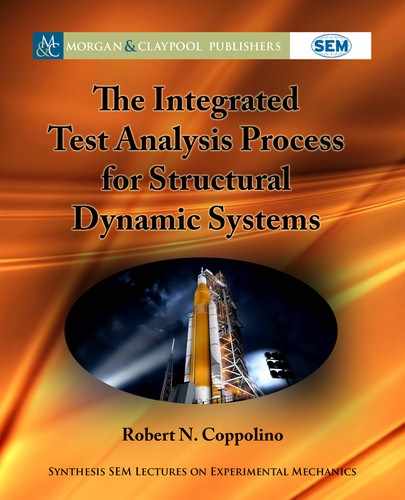
2.2. PART 2: GUIDELINES FOR SYSTEMATIC MODEL DEVELOPMENT 29
Sensitivity of Empty Shell Frequencies Ullage Pressure
P
0
= 0 psi
P
0
= 30 psi
10
2
10
1
10
0
Frequency (Hz)
0 2 4 6 8 10 12 14 16
Circumferential Harmonic (n)
Figure 2.10: Modal density and sensitivity of empty shell natural frequencies to ullage pressure.
a. Bulge (n D 0) bulge and lateral (n D 1) natural frequencies are associated with membrane
strain energy.
b. Bulge (n D 0) bulge and lateral (n D 1) natural frequencies are insensitive to ullage pressure.
c. Shell breathing (n > 1) natural frequencies are associated with membrane and flexural strain
energies.
d. Shell breathing (n > 1) natural frequencies are sensitive to ullage pressure.
e. Shell natural frequencies are profoundly sensitive to added fluid mass.
f. Axial and torsion natural frequencies are unaffected by fluid mass and ullage pressure.
2.2.14 FREE SURFACE SLOSH MODES
A discussion of the modal behavior of a fluid-filled structure is incomplete without inclusion of
free surface slosh modes. e pendulum mechanics of slosh are thoroughly discussed by Abram-
son [19], who described theoretical foundations, experimental results, and a variety of simplified,
lumped parameter dynamic models. Fluid-structure interaction FEMs that include free surface
effects, developed by Zienkiewicz [8], have been implemented in various finite element software
packages. Of primary importance to Abramson’s fluid-filled circular cylindrical shell is the fact
that the fundamental free surface slosh modes occur at frequencies (0.35 Hz) sufficiently be-
low the lowest flexible structure-fluid mode (1.20 Hz) to be modeled separately as interactions
between the sloshing fluid and “rigid” container structure. As a result of situations of this type,
..................Content has been hidden....................
You can't read the all page of ebook, please click here login for view all page.
